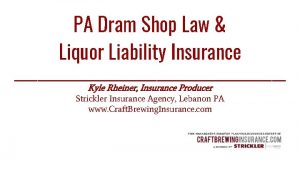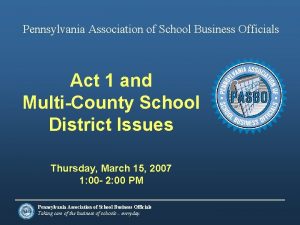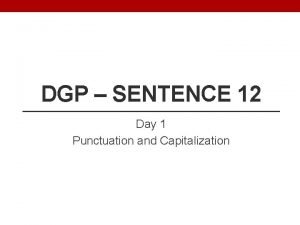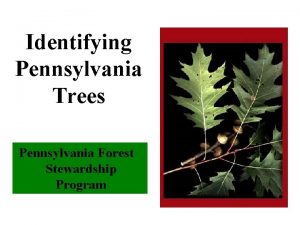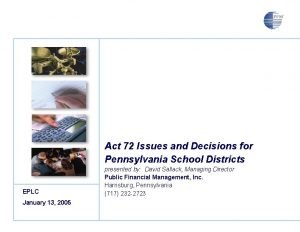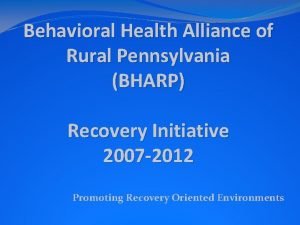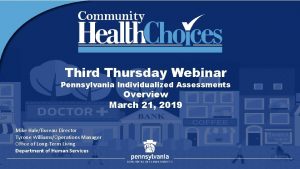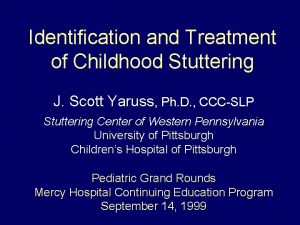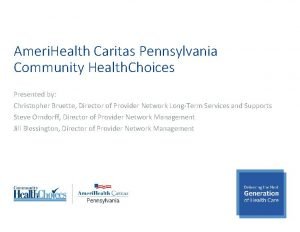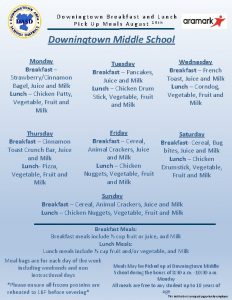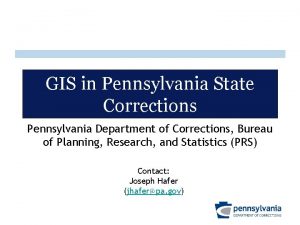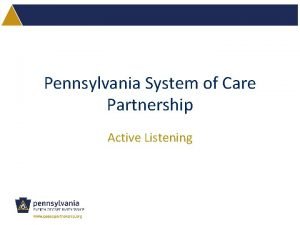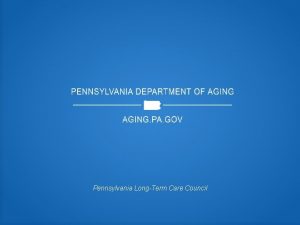Downingtown PAYS 2017 WHAT IS PAYS The Pennsylvania































- Slides: 31

Downingtown PAYS 2017

WHAT IS PAYS? The Pennsylvania Youth Survey (PAYS) is a student survey administered in oddnumbered years (e. g. , 2013, 2015, 2017) to youth in 6 th, 8 th, 10 th, and 12 th grades in participating schools throughout the Commonwealth. All Chester County Public Schools participated in the 2017 PAYS. The questions asked in the survey cover many types of attitudes, knowledge, behaviors, and experiences. Youth respond to questions on topics such as: § Use of alcohol, tobacco, and other drugs (ATOD) § Violence and drugs on school property § Being bullied and internet safety § Involvement in gangs § Depression § Gambling

PAYS CONTINUED: Youth also answer questions related to risk and protective factors (RPF). Risk Factors increase the chances of a youth having problems, and Protective Factors decrease the chances. RPF questions in the PAYS cover many areas of youths’ lives, including: § Community § School § Family § Peer § Individual The PA Commission on Crime and Delinquency (PCCD) sponsored the administration of the PAYS since 1989. In 2013, the PA Dept. of Education (PDE) and PA Dept. of Drug and Alcohol Prevention (DDAP) joined PCCD in sponsoring school-district participation in the survey.

GOALS OF THE PAYS DATA IS TO IDENTIFY THE STRENGTHS AND CHALLENGES FELT BY YOUTH IN OUR COMMUNITY Where are students successful? § Look for low percentages of students reporting behaviors such as drug use, bullying, anxiety and/or depression. Where are students struggling? § Look for high percentages of students reporting behaviors like drug use, bullying, anxiety and/or depression. Trends over time of higher percentages over county average.

OVE RA LL D IS TR IC T STRENG TH S DEFINED AS PRIORITY AREAS WHERE DASD HAD WORSE RESULTS THAN THE COUNTY OR STATE AVERAGE IN AT LEAST ONE GRADE LEVEL § Decreases in 30 day alcohol usage and binge drinking in grades 10 and 12 § Low percentages of students reporting usage of heroin, prescription drugs, cigarettes, cocaine, methamphetamine, etc. § High percentages of students reporting that they have access to teachers. § High percentages of students reporting that they have opportunity to be involved in class discussions or activities § High percentage of students reporting involvement in community activities § Low percentage of students impacted by mobility § Low percentage of students impacted by grief or other stressful events

OVERALL DISTRICT CONCERNS DEFINED AS PRIORITY AREAS WHERE DASD HAD WORSE RESULTS THAN THE COUNTY OR STATE AVERAGE IN AT LEAST ONE GRADE LEVEL § 30 Day usage of marijuana § Driving under the influence of marijuana § Attitudes towards marijuana use § Vaping § Percentage of students who feel safe at school § Perceived Importance of School § Percentage of Students who enjoy being at school § Percentage of Students who have had inappropriate sexual contact through technology § Percentage of students who report bullying based on -the color of their skin -their religion § Percentage of students who feel sad or depressed most days -their accent § Percentage of students who have considered suicide -the country where their parents or grandparents were born § Percentage of students who have planned suicide -the country where they were born -their grades or school achievement -their gender

30 Day Usage of Marijuana How many times (if any) have you used marijuana (pot, Hashish, cannabis, weed) during the past 30 days? 60 50 40 34. 5 30 25. 2 25. 7 24. 5 20. 8 20 11. 6 12. 3 12. 6 12. 4 12 10 0. 3 0 0. 1 0. 5 0. 4 0. 5 Grade 6 Dtown 2013 1. 5 0. 9 3. 5 3. 3 4. 6 Grade 8 Dtown 2015 Grade 10 Dtown 2017 CC 2017 Grade 12 PA 2017

Driving After Marijuana Use 50 How often have you driven a car while or shortly after using marijuana (pot, Hash, cannabis, weed)? 45 40 35 30 23. 2 25 20 16. 7 13. 8 15 11. 1 10 5 0. 4 0 0. 2 0. 3 0. 1 0. 3 Grade 6 Dtown 2013 0. 8 0 0 0. 4 0. 8 2. 8 1. 6 Grade 8 Dtown 2015 1. 9 1. 7 Grade 10 Dtown 2017 CC 2017 Grade 12 PA 2017 10. 3

Vaping / E-cigarette 30 Day Usage How frequently have you used an electronic vapor product such as e-cigarettes, e-cigars, e-pipes, vape pens during the past 30 days? 50 45 38. 4 40 34. 3 35 29. 6 30 24 25 20 29. 3 21. 8 21. 9 15 10 5 0. 7 1. 3 2. 3 9. 3 10. 9 3. 7 0 Grade 6 Grade 8 Dtown 2015 Dtown 2017 Grade 10 CC 2017 Grade 12 PA 2017

Mental Health Concerns Feeling Depressed Or Sad In the past 12 months have you felt depressed or sad MOST days, even if you feel OK sometimes? 50 45 40 37. 7 36. 8 36 36. 9 32. 3 35 31. 2 27. 4 30 22. 9 23. 7 25 20 42. 2 41. 4 23 25. 7 27 34. 4 35. 6 40. 8 36. 6 29. 9 17. 5 15 10 5 0 Grade 6 Dtown 2013 Grade 8 Dtown 2015 Grade 10 Dtown 2017 CC 2017 Grade 12 PA 2017

Mental Health Concerns Considered Suicide 50 During the past 12 months, did you ever seriously consider attempting suicide? 45 40 35 30 23. 1 25 20 16. 2 16. 5 17. 7 13. 6 15 11 10 5 17. 2 16. 6 21 20. 2 18. 9 4 5. 6 4. 9 6. 7 8. 8 19. 9 15. 7 10 10. 8 0 Grade 6 Dtown 2013 Grade 8 Dtown 2015 Grade 10 Dtown 2017 CC 2017 Grade 12 PA 2017

Bullying and Internet Safety Percentage of students indicating some bullying in the past 12 months Inappropriate Sexual Contact through Technology 35 35 30 30 25 25 20 20 15 15 10 10 5 5 0 0 8 th Grade Dtown 2015 10 th Grade Dtown 2017 12 th Grade State

Perceived Reasons for Bullying The color of my skin The country where my family (parents, grandparents) was born 12 6 10 5 8 4 6 3 4 2 2 1 0 0 6 th Grade 8 th Grade Dtown 2015 10 th Grade Dtown 2017 12 th Grade State

Perceived Reasons For Bullying My grades or school achievement 20 My Gender My Religion 14 18 12 12 16 10 10 14 12 8 8 10 6 8 6 6 4 4 4 2 0 6 th 8 th Dtown 2015 10 th Dtown 2017 12 th State 2 2 0 0 6 th 8 th Dtown 2015 10 th Dtown 2017 12 th State

Risk and Protective Factors measured in the PAYS data need to be addressed to promote a healthy, safe, and supportive community for our children. These factors directly impact the attitudes and behaviors reported by our students and are specific to our community.

Protective Factors – Areas Of Concern LOWEST SCORING PROTECTIVE FACTORS § Religiosity (42%) – In communities where young people attend religious programs, services, or groups regularly, there is a lower percentage of anti-social behaviors and ATOD use. § Community Rewards for Pro Social Involvement (44. 8%) – Rewards for positive participation in community activities that help students bond to the community and increase self-respect as well as respect for community.

Protective Factors, or assets, exert a positive influence and buffer against the negative influence of risk, thus reducing the likelihood that adolescents will engage in problem behaviors. Three Highest Overall scores for Protective factors § Family Attachment (70. 5%) – Young people feel they are a valued part of their family. ) § Family Rewards for Prosocial Involvement (68. 8%) – (When parents, siblings, and other family members praise, encourage, and attend to things done well by their child). § Family Opportunities for Prosocial Involvement (68. 7%) – (Young people are exposed to more opportunities to participate meaningfully in the responsibilities and activities of the family. )

Risk Factors are defined as characteristics in the community, family, school and individual’s environment known to increase the likelihood that a youth will engage in more than one problem behavior. In a community where there is acceptance and tolerance of these risk factors, students are more likely to engage in problem behaviors. Lowest scores for RISK factors: § Gang Involvement (10% risk) § Perceived Availability of Handguns in the Community (18. 6% risk) § Interaction with Antisocial Peers (20. 3% risk)

Risk Factors – Areas Of Concern HIGHEST RISK FACTORS • Parental Attitudes Favorable Toward Drugs and Antisocial Behavior (43. 1%) – In families where parents use illegal drugs, are heavy drug users of alcohol, are tolerant of children’s use, children are more likely to become drug users in adolescence. Risk is further increased if parents involve children in their own drug / alcohol using behavior. • Low Commitment toward School (41. 8%) – Liking school, spending time on homework, and perceiving the coursework as relevant. • Perceived Risk of Drug use (40. 2%) – Do not perceive drug use to be risky.

Wellness Goals For 2019 • Goal #1 - To increase protective factors and decrease risk factors associated with the use and abuse of harmful substances and behaviors. • Outcome: Increase prevention of substance use and abuse through education and awareness for parents, staff and students. • Outcome: Engage youth in advocacy initiatives to raise awareness and educate peers on effects and substance use and abuse

Wellness Goals For 2019 • Goal #2 - To promote safe and supportive schools for positive school culture, and healthy social and emotional development. • Outcome: Increase mental health and suicide prevention education for parents, staff, and students. • Outcome: Increase prevention education addressing bullying (e. g. cyber, texting/sexting, verbal, physical bullying including gender, race, religion, ethnicity, sexual identity/orientation) for parents, staff, and students.

Wellness Goals For 2019 • Goal #3: Sustain a healthy school environment for healthy eating and physical activity. • Outcome: Meet criteria and compliance with the Downingtown Area School District wellness policy including: nutrition education, physical activity, food services, nutrition standards, and other school-based activities.

End of primary presentation on 2019 focus. Additional slides follow for comparison to past results and trends.

Risky Substance Use Related Behavior Driving After Alcohol Use 50 How often have you driven a car while or shortly after drinking? 45 40 35 30 25 20 15 10 5 0. 7 0. 8 0 Grade 6 0. 4 0 0 1. 1 Grade 8 Dtown 2015 1. 6 0. 9 1. 3 Grade 10 Dtown 2017 State 3. 9 6. 3 Grade 12 5. 5

30 Day Usage - Alcohol How many times (if any) have you had beer, wine or hard liquor during the past 30 days? 50 43. 9 45 41. 3 40 37. 6 35 30 25 22. 3 19. 7 20 15 8. 1 10 5 1. 9 3. 8 3. 3 9. 5 4. 4 0 Grade 6 Grade 8 Dtown 2015 Grade 10 Dtown 2017 Grade 12 PA 2017

Attitudes Towards Peer Use - Alcohol How much do you think people risk harming themselves if they take five or more drinks of an alcoholic beverage once or twice a week? (% of surveyed youth who disapprove of regular use of alcohol) 100 90 80 76. 6 77 77. 2 76. 9 82. 4 84. 5 84. 1 80. 1 70. 5 73. 2 76. 9 82. 6 80. 7 78. 4 72. 7 70 77. 7 77. 2 65. 9 73 60 50 40 30 20 10 0 Grade 6 Grade 8 Dtown 2013 Dtown 2015 Grade 10 Dtown 2016 CC 2017 Grade 12 PA 2017 68. 4

Attitudes Towards Peer Use - Marijuana 100 96 How do you feel about someone your age using marijuana once a month or more? (% of surveyed youth who disapprove of regular use of marijuana) 96. 5 93. 9 92. 9 90. 7 90 88. 9 88. 5 86. 3 83. 8 80. 5 80 65. 1 70 57. 9 56. 3 56. 9 56. 3 60 50 37. 6 38. 4 36. 4 39. 1 40 30 20 10 0 Grade 6 Grade 8 Dtown 2013 Dtown 2015 Grade 10 Dtown 2017 CC 2017 Grade 12 PA 2017 43. 4

Commitment To School – Positive School Environment I feel safe at my school. 100 95. 7 95 94. 2 94. 1 93. 1 91. 5 89. 5 90 91 90. 7 91. 3 91 89. 2 87. 6 87. 9 92. 3 88. 2 87. 9 85. 3 85 82. 9 82. 1 80. 2 80 75 70 Grade 6 Grade 8 Dtown 2013 Dtown 2015 Grade 10 Dtown 2017 CC 2017 Grade 12 PA 2017

Commitment To School – Perceived Importance Of School How important do you think the things you are learning in school are going to be for your later life? ( responses very or quite important) 100 90 80 88. 3 83. 6 83. 3 80. 2 80. 3 72. 2 65. 8 70 60 53. 7 58. 3 59. 3 57. 7 48. 3 50. 4 50. 3 50 47 47. 4 45. 9 49. 9 42. 7 40 30 20 10 0 Grade 6 Grade 8 Dtown 2013 Dtown 2015 Grade 10 Dtown 2017 CC 2017 Grade 12 PA 2017 46. 3

Commitment To School – Perceived Importance Of School Now thinking back over the past year in school, how often did you enjoy being in school? 100 90 80 70 60 65. 1 59. 1 57. 3 55. 9 51. 2 53. 8 50 45. 9 47. 4 42. 5 46. 7 42. 5 44. 3 40 38. 4 34. 8 36. 1 36. 6 37. 9 38. 6 30 20 10 0 Grade 6 Grade 8 Dtown 2013 Dtown 2015 Grade 10 Dtown 2017 CC 2017 Grade 12 PA 2017 34

Commitment To School – Perceived Importance Of School How often do you feel that the school work you are assigned is meaningful and important? (answering often or almost always) 100 90 80 70 73. 2 69. 1 70. 2 65. 7 65. 8 60 50. 5 51. 6 41. 1 42. 6 43. 7 50 40. 5 40 29. 2 30 32. 3 30. 2 29. 5 25. 3 26. 7 24. 9 26. 6 26. 7 20 10 0 Grade 6 Grade 8 Dtown 2013 Dtown 2015 Grade 10 Dtown 2017 CC 2017 Grade 12 PA 2017
 Downingtown west freshman football
Downingtown west freshman football Kochelsee
Kochelsee Pennsylvania ecosystems
Pennsylvania ecosystems Who killed dr john yelenic
Who killed dr john yelenic Pa dram shop law
Pa dram shop law Xoom energy pennsylvania
Xoom energy pennsylvania Pennsylvania association of school business officials
Pennsylvania association of school business officials My uncle from pittsburgh pennsylvania recently bought
My uncle from pittsburgh pennsylvania recently bought Pennsylvania state animal response team
Pennsylvania state animal response team California university of pennsylvania global online
California university of pennsylvania global online Atlantic coastal plain pa
Atlantic coastal plain pa Summer key for pennsylvania trees
Summer key for pennsylvania trees Modern real estate practice in pennsylvania 14th edition
Modern real estate practice in pennsylvania 14th edition Pennsylvania dutch council
Pennsylvania dutch council Act 72 pennsylvania
Act 72 pennsylvania Modern real estate practice in pennsylvania
Modern real estate practice in pennsylvania New hire reporting program
New hire reporting program Mayflower compact significance
Mayflower compact significance Behavioral health alliance of rural pennsylvania
Behavioral health alliance of rural pennsylvania Pennsylvania space grant consortium
Pennsylvania space grant consortium Nfce pennsylvania
Nfce pennsylvania Rachel carson was born in 1907 in springdale pennsylvania
Rachel carson was born in 1907 in springdale pennsylvania Servient tenement
Servient tenement A harvest of death gettysburg pennsylvania
A harvest of death gettysburg pennsylvania Stuttering center of western pennsylvania
Stuttering center of western pennsylvania New york pennsylvania new jersey delaware
New york pennsylvania new jersey delaware Hospital university of pennsylvania
Hospital university of pennsylvania Community health
Community health Free radon test kit pennsylvania
Free radon test kit pennsylvania Pennsylvania
Pennsylvania Pennsylvania
Pennsylvania Pennsylvania forest products association
Pennsylvania forest products association




